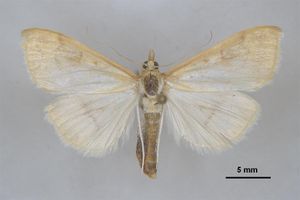

 +27Kontinente:EUASOC
+27Kontinente:EUASOC3. Biologie
3.1. Nahrung der Raupe
- [Poaceae:] Zea mays (Mais)
- [Poaceae:] Sorghum bicolor (Mohrenhirse, Sorgho, Sorghum-Hirse, Durrakorn)
- [Salicaceae:] Salix viminalis (Korb-Weide)
Die Art gilt in Ostasien als massiver Schädling an Mais (z.B. Trisyono et al. (2025)), wobei die junge Raupe zunächst Blätter befrisst und sich erst später in den Stängel hineinbohrt. Aber natürlich kann Mais weder die einzige noch die primäre Raupennahrung der Art sein.
Auf [mothphotographersgroup.msstate.edu] wurde zusammengetragen: "Serious pest of Zea mays (maize/corn) on Guam. Has been recorded on multiple different hosts (representing the Compositae, Gramineae, Cannabaceae, and Solanaceae) including, but not limited to: hemp, bell and chili pepper, hop, sugar cane, millet, foxtail millet, green foxtail, eggplant, Sorghum, and Johnson grass." Sucht man weiter im Internet, findet man noch Pflanzen ganz anderer Familien. Vieles davon dürfte auf Fehlbestimmungen der Raupen zurückgehen - doch was denn jetzt wirklich stimmt, ist mir noch nicht klar.
Sorghum wird oft genannt, und mit im Schnitt 2-3 Raupen pro Pflanze an Sorghum bicolor in der Untersuchung von in Süd-Sulawesi (Indonesien), ist es auch plausibel, dass O. furnicalis mit als Schädling an der Mohrenhirse gilt. Nonci et al. (2023) erläutern in ihrem Abstract: "The research with aim of collecting and inventorying several pests of sorghum (Sorghum bicolor L. Moech) crops was carried out in Bajeng Agricultural Technology Research and Development Installation, Gowa District, South Sulawesi, and Entomology Laboratory of Indonesian Cereals Research Institute from March until October 2021 and from March until July 2022. Observations on 11 sorghum varieties [...] and several types of pests attacked were carried out at vegetative and generative stages by determined 25 plant samples at random. The results in 2021 showed that at vegetative stages, pests were Ostrinia furnacalis Gueene, Sesamia inferens Walker, Spodoptera frugiferda JE Smith, and Aphis sp. each with a population of 1-3 larvae/plant, 5-13 larvae/plant, and 1-2 larvae/plant respectively, while the scoring of Aphis sp. between 5-7 for all varieties of sorghum. At the generative stage of O. furnacalis and Nola sorghiella Riley was found with a population between 3-5 larvae/panicle, 9-13 larvae/panicle [...]. In 2022 at the vegetative and generative stage, the same pests’ species were found with O. furnacalis were 1-2 larvae/plant, S. inferens 3-5 larvae/plant, and S. frugiferda 1-2 larvae/plant. [...]. At the generative stage, O. furnacalis, N. sorghiella, Heliothis sp., and Aphis sp. were found. Each pest species was 3-5 larvae/panicle, 9-13 larvae/panicle, and 1-2 larvae/panicle [...]."
Jiang et al. (2023) stellen eine Tabelle mit genau 70 in der Literatur gefundenen Raupennahrungspflanzen aus 21 verschiedenen Pflanzenfamilien zusammen, davon die Asteraceae mit 18 und die Poaceae mit 13 Arten. Hätte ich mir heraussuchen dürfen, welche Familie ich am meisten anzweifle, hätte ich die Salicaceae mit den zwei Arten Populus euramericana und Salix viminalis gewählt. Doch der Titel der Arbeit ("First record of damage to Salix viminalis L. by Ostrinia furnacalis (Guenée) (Lepidoptera: Crambidae)") deutet an, dass ich mich geirrt haben könnte. Und tatsächlich: " In October 2021, local farmers in Heilongjiang Province, China, observed a new lepidoptera species with the larvae severely damaging S. viminalis. In this study, by DNA-barcoding and phylogenetic analysis, the pest was identified as O. furnacalis. To the best of our knowledge, this is the first report on the likelihood of O. furnacalis being a pest on S. viminalis, thus highlighting the necessity to establish monitoring and management plans in S. viminalis-growing regions prior to economic loss." Die Bestimmung wurde also auch noch mit Borcode abgesichert. Damit spricht hier doch alles für eine hochgradig polyphage Art. Und irgendwie passt dann auch doch die Korb-Weide - die Raupen wurden ja nicht auf einem alten Baum gefunden, sondern in den "Stämmen" der ein Jahr alten Neupflanzungen.
Auch Abbas et al. (2025) stellten eine lange Liste von Nahrungspflanzen zusammen, darunter den Mais an erster Stelle: "Among the various types of host plants, maize (Zea mays) is the preferred host plant of ACB (Nafus and Schreiner, 1991; Afidchao et al., 2013; Shen et al., 2020). Young larvae create small pinhole feeding on the leaves. Mature larvae bore into the stems, tassels and cobs. It also attacks the following plant families: Apocynaceae, Cannabaceae, Cucurbitaceae, Malvaceae, Gramineae, Solanaceae, Gingiberaceae, Polygonaceae, Phytolaccaceae, Poaceae and Zingiberaceae (Nafus and Schreiner, 1991; Ishikawa et al., 1999; Grahame, 2022). Some of the alternative host plants that the ACB may attack before moving to maize crop include, Abutilon theophrasti, Amaranthus spp., Apocynum cannabium, Arachis hypogaea, Artemisia spp., A. tricolor, Brassica oleracea, B. campestris, B. pekinensis, Blumea lacera, Capsicum annuum, C. frutescens, C. coronarium, Coix lacrymajobi, Glycine max, Gossypium spp., Helianthus annuus, Hibbertia scandens, Humulus lupulus, Lactuca sativa, Oryza sativa, Panicum miliaceum, Pennisetum glaucum, Pisum sativum, Polygonum lapathifolium, Proteus vulgaris, P. viride, Ricinus communis, Saccharum officinarum, S. spontaneum, Setaria italica, Solanum melongena, S. nigrum, Sorghum bicolor, S. sudanense, S. viridis, Spinacia oleracea, Triticum aestivum, Urochloa mutica, Vigna radiata, V. angularis, Vicia faba, V. unguiculata, and Xanthium sibiricum (Atwal, 1976; Talekar et al., 1991; Tan et al., 2011; Afidchao et al., 2013; Chen et al., 2015; Yuan et al., 2015; Su et al., 2016; Wei and Chen, 2020; Grahame, 2022) and grasses (barnyard grass, Johnson grass and other wild grasses)."
(Autor: Erwin Rennwald)
4. Weitere Informationen
4.1. Andere Kombinationen
- Botys furnacalis Guenée, 1854 [Originalkombination]
4.2. Faunistik
Guenée (1854) beschrieb seine neue Art von "Nouvelle Hollande", eine damals nicht unübliche Umschreibung von Australien. Ob die Art schon sehr früh dorthin verschleppt wurde, oder ob Australien zum natürlichen Verbreitungsgebiet der Art gehört, scheint bis heute ungeklärt zu sein. Jedenfalls ist sie heute am Ostrand und im Norden Australiens weit verbreitet. Die Art hat ihren Verbreitungsschwerpunkt im südöstlichen Asien, wo sie westwärts bis Afghanistan und Pakistan vorkommt und nordwärts bis ins den Südosten Russlands verschleppt wurde (Abbas et al. (2025)). So gilt sie z.B. in China (Shen et al. (2019) und in Indonesien (Trisyono et al. (2025)) als massiver Schädling an gepflanztem Mais. Wie Shen et al. (2019) zeigen konnten, gibt es im Nordosten Chinas regelmäßig windunterstützte Langstrecken-Wanderungen bereits befruchteter Weibchen nord- und nordostwärts über den Golf von Bohai.
Huemer et al. (2025) führten eine umfangreiche Barcoding-Studie an Lepidoptera von Kreta durch. Völlig überraschend stießen sie dabei auf ein Exemplar von O. furnacalis, die damit erstmals für Europa nachgewiesen wurde. Aber wer - bitteschön - schaut sich in Südosteuropa denn im Normalfall die Maiszünsler so genau an ? Gut möglich, dass diese Art längst mit dem Maisanbau weiter verbreitet ist.
(Autor: Erwin Rennwald)
4.3. Literatur
- Abbas, A., Saddam, B., Ullah, F.,Hassan, M.A., Shoukat, K. Hafeez, F., Alam, A., Abbas, S., Ghramh, H.A., Khan, K.A., Iqbal, R., Dara M.Z.N., Ali, J. & C.R. Zhao (2025): Global distribution and sustainable management of Asian corn borer (ACB), Ostrinia furnacalis (Lepidoptera: Crambidae): recent advancement and future prospects. — Bulletin of Entomological Research, 115 (1): 105-120. doi: 10.1017/S0007485324000919. [Abstract auf pubmed.ncbi.nlm.nih.gov]
- Erstbeschreibung: Guenée (1854): Deltoïdes et Pyralites. = Boisduval & Guenée (1854): Histoire naturelle des Insectes. Species général des lépidoptères 8: 1-448. Paris (Roret). [Digitalisat auf biodiversitylibrary.org]
- Huemer, P., Berggren, K., Aarvik, L., Rennwald, E., Hausmann, A., Segerer, A., Staffoni, G., Aspaas, A.M., Trichas, A. & P.D.N. Hebert (2025): Extensive DNA Barcoding of Lepidoptera of Crete (Greece) Reveals Significant Taxonomic and Faunistic Gaps and Supports the First Comprehensive Checklist of the Island’s Fauna. — Insects 2025, 16, 438: 1-21. https://doi.org/10.3390/insects16050438. [zum open access-Artikel mit PDF-Download auf mdpi.com]
- Jiang, T. Wang, H., Feng, T., Yang, R. & Y. liu (2023): First record of damage to Salix viminalis L. by Ostrinia furnacalis (Guenée) (Lepidoptera: Crambidae). — Cogent Food & Agriculture, 9: 2170936. DOI: 0.1080/23311932.2023.2170936. [PDF auf tandfonline.com]
- Nonci, N., Sebayang; A. & R. Arief (2023): Collection and inventory of pests on several sorghum varieties. — IOP Conf. Series: Earth and Environmental Science, 1253 (1): 012004. Doi:10.1088/1755-1315/1253/1/012004. [zum PDF-Download auf researchgate.net]
- Shen, X., Fu, X., Huang, Y., Guo, J., Wu, Q., He, L., Yang, X. & K. Wu (2019): Seasonal Migration Patterns of Ostrinia furnacalis (Lepidoptera: Crambidae) Across the Bohai Strait in Northern China. — Journal of Economic Entomology, 20 (20): 1–9. Doi: 10.1093/jee/toz288. [zum PDF-Download auf researchgate.net]
- Trisyono, Y.A., Aryuwandari, V.E.F., Sinulingga, N.G.H. & I.P. Andika (2025): Damage assessment of the Asian corn borer, Ostrinia furnacalis (Lepidoptera: Crambidae), in corn production centers in Indonesia. — Heliyon, 11: e42795. [zum Artikel auf sciencedirect.com]






























